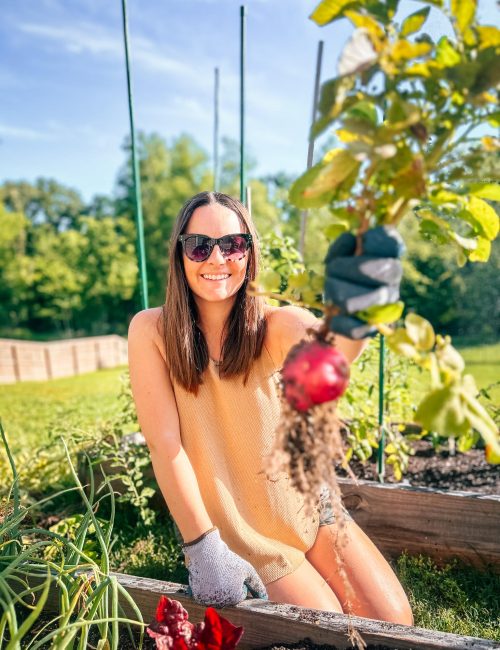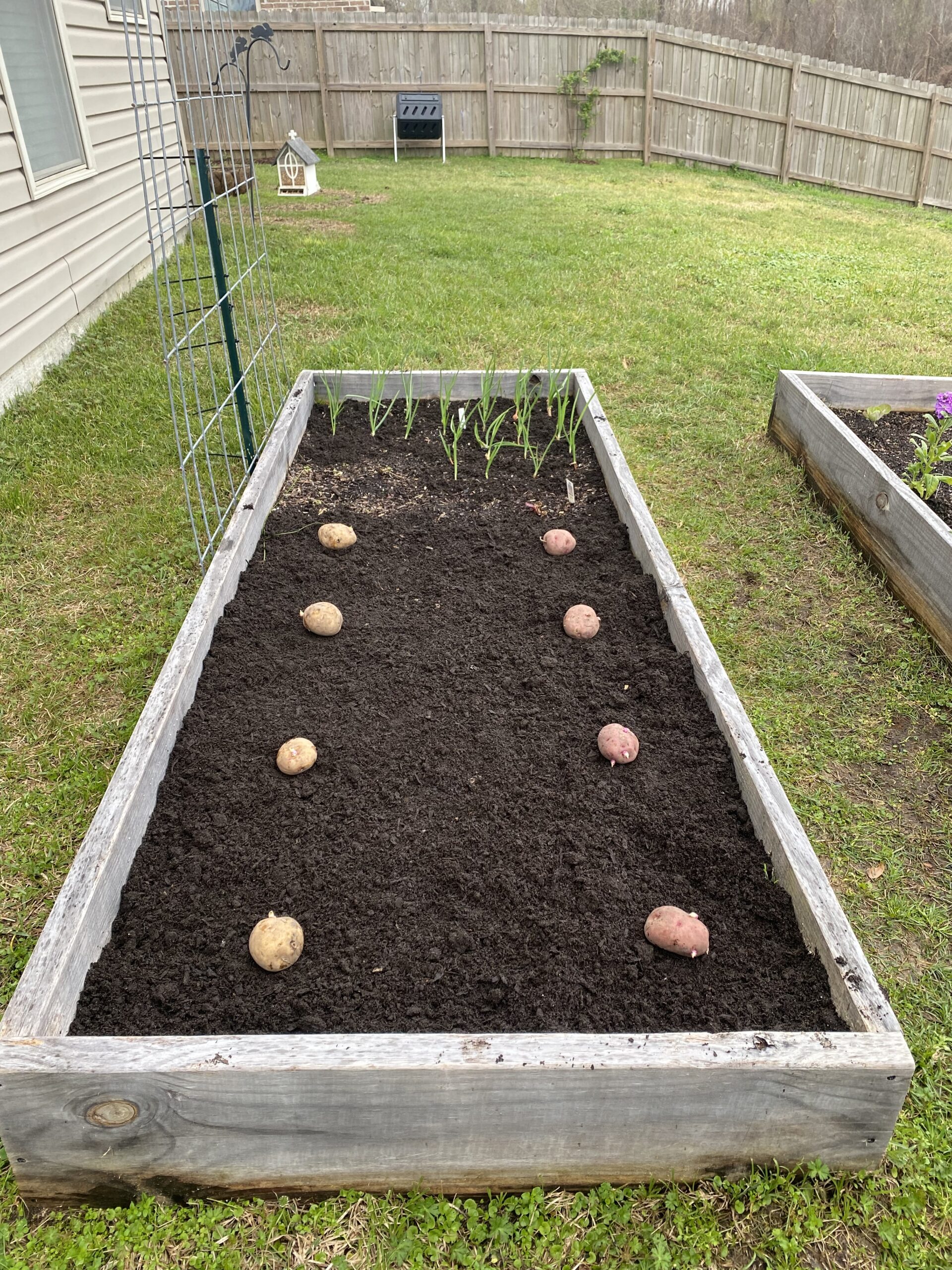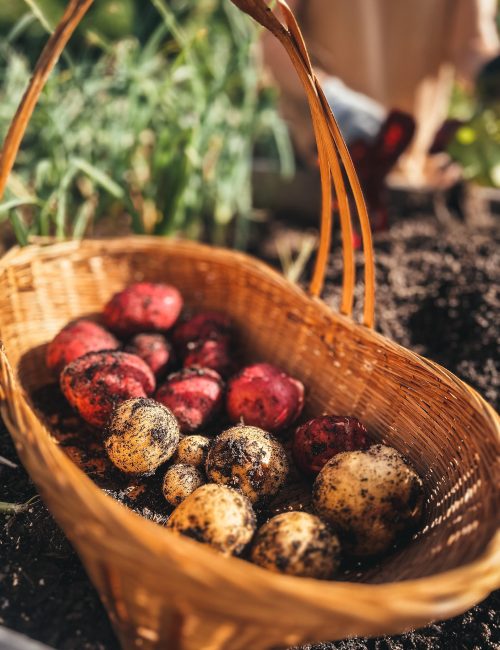If someone were to ask me what my favorite food on this earth is. My answer would be steak and potatoes.
Potatoes are the best. You can do so much with them – mashed potatoes, baked potatoes, roasted potatoes, french fries, hash browns, potatoes au gratin, etc. Are you drooling Yet?
You get the picture. The opportunities are endless and, not to mention, delicious.
This was the first year that I was able to grow potatoes successfully. Albeit, not as much as I’d hoped. Five pounds of potatoes won’t get you very far….but you can bet your bottom dollar that I’m going to enjoy every last bite of them!
There is something about new potatoes that taste even better than the store-bought ones.
Below I’m going to walk through the potato process I used this year. Just an FYI – I am no potato growing master.

Important Info:
- The time to plant potatoes in zone 9 is Mid-January to Mid-February. (I planted mid-February this year)
- These 2 varieties do well in Louisiana: Yukon Gold and Red LaSoda
Source your Seed Potatoes:
- Seed Potatoes: Check your local garden center to see if they sell seed potatoes. These are potatoes that are less likely to rot when planted. I know Clegg’s Nursery sells seed potatoes. If you can’t find them locally, I believe you can order them online.
- Organic Potatoes: If for some reason you can’t use seed potatoes, another option would be to buy a bag of organic potatoes from the grocery store and use those. (My mom has done this before)
Prep your Potatoes:
- Chitting: Once I acquired the seed potatoes, I threw them in a basket near a window to let them “chit”. “Chitting” is when you leave them in a cool, light place so they begin to sprout. This will give you a head start on your potatoes, however this step is not necessary. (I bought my seed potatoes about 1 month before planting so I kept them in the pantry for a couple of weeks and then put them near a window just a few days before I was ready to plant.)
Where are you going to plant?
- Pick your potato spot: You can grow potatoes in-ground, in raised beds, or in grow bags. Whatever you choose to plant your potatoes in, make sure it has good drainage. Did I mention potatoes do not like to be wet constantly?!
- Companion plants for potatoes: According to a post by Home for the Harvest, “The best companion plants for potatoes include culinary herbs like chives, thyme, and basil, vegetables like onion, beans, celery, and corn, and flowers like nasturtium and marigold. Avoid planting potatoes nearby brassicas (cabbage family), carrots, and squash.” (I planted in the same bed as onions).
It’s Time to Plant!


- Check the forecast: When you are ready to plant your potatoes, make sure to look at the upcoming weekly weather forecast. Avoid planting when tons of rain is scheduled. Potatoes will rot with too much moisture. Just remember: the drier the better.
- Pick your soil/compost: I recommend planting your potatoes in compost. I filled my raised beds up with Black Kow compost. I know what you’re thinking – “That seems like a ton of compost. Won’t I burn my plants?”. The answer is no! Potatoes are heavy feeders and need the extra nutrients. If you are using a grow bag, compost or organic potting soil should be fine.
- Plant spacing: Plant potatoes 12”-18” a part and 6 – 12” deep. (I planted mine about 18” a part and 12” deep. In retrospect, I probably could’ve planted closer together)
- Water: Water them in after planting and then leave them be! I rarely hand watered them during the growing season because we did get a good amount of rain. And if you didn’t hear me earlier in the article….DRY DRY DRY!! Potatoes don’t want to be wet. However they do need a little bit of water to survive so don’t starve them if they are extremely parched.
- Mounding? If you do some research on growing potatoes, you will notice that most people “mound” there potatoes. Meaning they plant the potatoes and then continue to mound soil on top of the plants every so often to make sure that the tubers (potatoes) do not see the sun. Potatoes will turn green if the sun shines directly on them. I did not mound soil on my potatoes because I chose to plant them extremely deep in the raised bed. Let’s say you only plant your potatoes 6” deep – I would recommend mounding soil around the base of the plant as it grows taller.
- Wait to harvest: 80-90 days later, the potatoes will be ready for harvest. You can tell because the green plants above the ground will start to turn yellow and eventually die. I’ve heard people wait until the tops are completely dead to harvest. I didn’t wait that long this year for fear that they may be rotting underground. Plus… I got a bit excited 😊

I hope some of this information was helpful to you.
Happy gardening, my friends.

